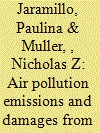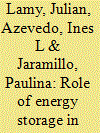|
|
|
Sort Order |
|
|
|
Items / Page
|
|
|
|
|
|
|
| Srl | Item |
| 1 |
ID:
150829


|
|
|
|
|
| Summary/Abstract |
This paper uses air pollution emissions data for the years 2002, 2005, 2008, and 2011 to estimate monetary damages due to air pollution exposure for PM2.5, SO2, NOx, NH3, and VOC from electric power generation, oil and gas extraction, coal mining, and oil refineries. In 2011, damages associated with emissions from these sectors totaled 131 billion dollars (in 2000$), with SO2 emissions from power generation being the largest contributors to social damages. Further, damages have decreased significantly since 2002, even as energy production increased, suggesting that, among other factors, policies that have driven reductions in emissions have reduced damages. The results of this analysis highlight the spatial heterogeneity of the impacts associated with the emissions of a given pollutant. In the past, environmental regulations have assumed that the benefits of air emissions reductions are homogenous across source location. This analysis suggests that policy designs that account for spatial differences in the impacts of air emissions could result in more effective environmental regulation. Accounting for such spatial heterogeneity in the benefits of policies would be akin to accounting for differences in compliances costs across states, which the EPA did when establishing the state emissions standards for the Clean Power Plan rule.
|
|
|
|
|
|
|
|
|
|
|
|
|
|
|
|
| 2 |
ID:
124085


|
|
|
|
|
| Publication |
2013.
|
| Summary/Abstract |
Jacobson et al. (2013) recently published a paper arguing the feasibility of meeting all of the energy demands in New York State with wind, solar, and water resources. In this forum we suggest that the authors do not present sufficient analysis to demonstrate the technical, economic, and social feasibility of their proposed strategy.
|
|
|
|
|
|
|
|
|
|
|
|
|
|
|
|
| 3 |
ID:
088267


|
|
|
|
|
| Publication |
2009.
|
| Summary/Abstract |
Using coal to produce transportation fuels could improve the energy security of the United States by replacing some of the demand for imported petroleum. Because of concerns regarding climate change and the high greenhouse gas (GHG) emissions associated with conventional coal use, policies to encourage pathways that utilize coal for transportation should seek to reduce GHGs compared to petroleum fuels. This paper compares the GHG emissions of coal-to-liquid (CTL) fuels to the emissions of plug-in hybrid electric vehicles (PHEV) powered with coal-based electricity, and to the emissions of a fuel cell vehicle (FCV) that uses coal-based hydrogen. A life cycle approach is used to account for fuel cycle and use-phase emissions, as well as vehicle cycle and battery manufacturing emissions. This analysis allows policymakers to better identify benefits or disadvantages of an energy future that includes coal as a transportation fuel. We find that PHEVs could reduce vehicle life cycle GHG emissions by up to about one-half when coal with carbon capture and sequestration is used to generate the electricity used by the vehicles. On the other hand, CTL fuels and coal-based hydrogen would likely lead to significantly increased emissions compared to PHEVs and conventional vehicles using petroleum-based fuels.
|
|
|
|
|
|
|
|
|
|
|
|
|
|
|
|
| 4 |
ID:
150718


|
|
|
|
|
| Summary/Abstract |
Over the last decade there have been a growing number of federal and state regulations aimed at controlling air emissions at power plants and/or increasing the penetration of renewable resources in the grid. Environmental Protection Agency regulations will likely lead to the retrofit, retirement, or replacement of coal-fired power plants while the state Renewable Portfolio Standards will continue to drive large-scale deployment of renewable energy sources, primarily wind. Combined, these changes in the generation fleet could have profound implications for the operations of the power system. In this paper, we aim to better understand the interaction between coal plant retirements and increased levels of wind power. We extensively analyze the operations of the PJM electricity system under a broad set of scenarios that include varying levels of wind penetration and coal plant retirements. Not surprisingly, we find that without transmission upgrades, retirement of coal-fired power plants will likely result in considerable transmission congestion and higher energy prices. Increased wind penetration, with high geographic diversity, could mitigate some of the negative effects of coal plant retirement and lead to a significant reduction in air emissions, but wind forecast error might impose operational constraints on the system at times of peak load.
|
|
|
|
|
|
|
|
|
|
|
|
|
|
|
|
| 5 |
ID:
150773


|
|
|
|
|
| Summary/Abstract |
Installations of rooftop solar photovoltaic (PV) technology in the United States have increased dramatically in recent years, in large part because of state and federal subsidies. In the future, such subsidies may be reduced or eliminated. From the homeowner's perspective, solar PV is competitive when it can produce electricity at a cost equivalent to the retail electricity rate, a condition sometimes referred to as “socket parity”. In assessing the economic viability of residential solar PV, most existing literature considers only a few locations and fails to consider the differences in PV system cost and electricity prices that exist across the U.S. We combined insolation data from more than 1000 locations, installation costs by region, and county-level utility rates to provide a more complete economic assessment of rooftop solar PV across the U.S. We calculated the break-even electricity prices and evaluated the reductions in installed costs needed to reach socket parity. Among the scenarios considered, we estimate that only Hawaii has achieved socket parity without the use of subsidies. With subsidies, six states reach socket parity, yet widespread parity is still not achieved. We find that high installation costs and financing rates are two of the largest barriers to socket parity.
|
|
|
|
|
|
|
|
|
|
|
|
|
|
|
|
| 6 |
ID:
104931


|
|
|
|
|
| Publication |
2011.
|
| Summary/Abstract |
Malaysia's transportation sector accounts for 41% of the country's total energy use. The country is expected to become a net oil importer by the year 2011. To encourage renewable energy development and relieve the country's emerging oil dependence, in 2006 the government mandated blending 5% palm-oil biodiesel in petroleum diesel. Malaysia produced 16 million tonnes of palm oil in 2007, mainly for food use. This paper addresses maximizing bioenergy use from oil-palm to support Malaysia's energy initiative while minimizing greenhouse-gas emissions from land-use change. When converting primary and secondary forests to oil-palm plantations between 270-530 and 120-190 g CO2-equivalent per MJ of biodiesel produced, respectively, is released. However, converting degraded lands results in the capture of between 23 and 85 g CO2-equivalent per MJ of biodiesel produced. Using various combinations of land types, Malaysia could meet the 5% biodiesel target with a net GHG savings of about 1.03 million tonnes (4.9% of the transportation sector's diesel emissions) when accounting for the emissions savings from the diesel fuel displaced. These findings are used to recommend policies for mitigating GHG emissions impacts from the growth of palm oil use in the transportation sector.
|
|
|
|
|
|
|
|
|
|
|
|
|
|
|
|
| 7 |
ID:
133079


|
|
|
|
|
| Publication |
2014.
|
| Summary/Abstract |
Replacing current generation with wind energy would help reduce the emissions associated with fossil fuel electricity generation. However, integrating wind into the electricity grid is not without cost. Wind power output is highly variable and average capacity factors from wind farms are often much lower than conventional generators. Further, the best wind resources with highest capacity factors are often located far away from load centers and accessing them therefore requires transmission investments. Energy storage capacity could be an alternative to some of the required transmission investment, thereby reducing capital costs for accessing remote wind farms. This work focuses on the trade-offs between energy storage and transmission. In a case study of a 200 MW wind farm in North Dakota to deliver power to Illinois, we estimate the size of transmission and energy storage capacity that yields the lowest average cost of generating and delivering electricity ($/MW h) from this farm. We find that transmission costs must be at least $600/MW-km and energy storage must cost at most $100/kW h in order for this application of energy storage to be economical.
|
|
|
|
|
|
|
|
|
|
|
|
|
|
|
|
| 8 |
ID:
150007


|
|
|
|
|
| Summary/Abstract |
Wind speeds in remote areas are sometimes very high, but transmission costs to access these locations can be prohibitive. We present a conceptual model to estimate the economics of accessing high quality wind resources in remote areas to comply with renewable energy policy targets, and apply the model to the Midwestern grid (MISO) as a case study. We assess the goal of providing 40 TWh of new wind generation while minimizing costs, and include temporal aspects of wind power (variability costs and correlation to market prices) as well as total wind power produced from different farms. We find that building wind farms in North/South Dakota (windiest states) compared to Illinois (less windy, but close to load) would only be economical if the incremental transmission costs to access them were below $360/kW of wind capacity (break-even value). Historically, the incremental transmission costs for wind development in North/South Dakota compared to in Illinois are about twice this value. However, the break-even incremental transmission cost for wind farms in Minnesota/Iowa (also windy states) is $250/kW, which is consistent with historical costs. We conclude that wind development in Minnesota/Iowa is likely more economical to meet MISO renewable targets compared to North/South Dakota or Illinois.
|
|
|
|
|
|
|
|
|
|
|
|
|
|
|
|
|
|
|
|
|